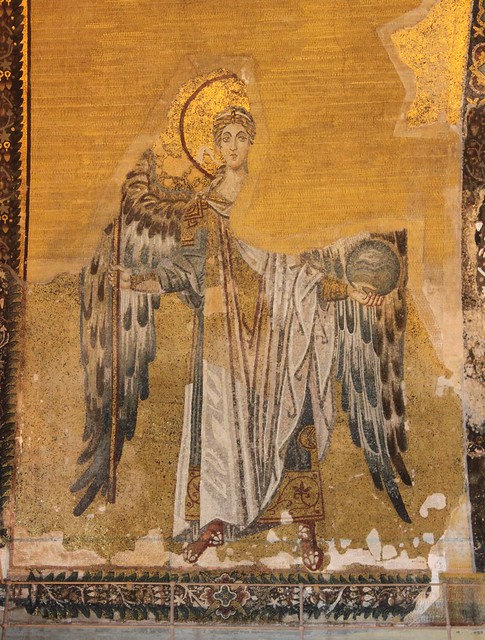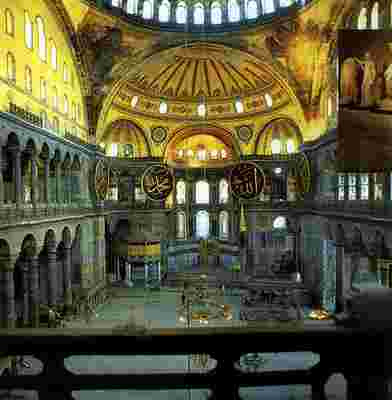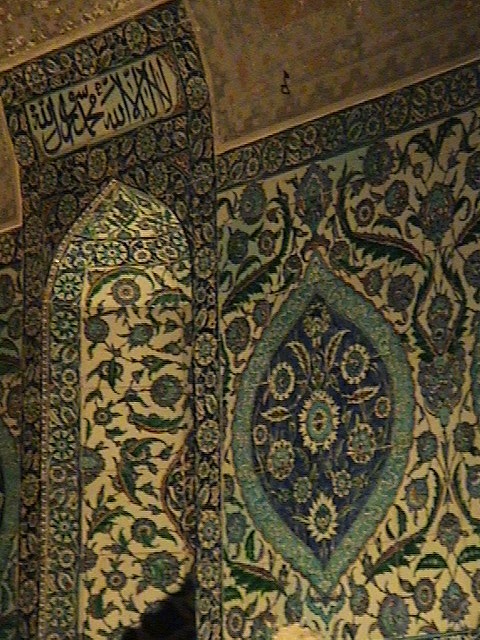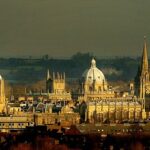



| The inner most circle in the central dome of Haghia Sophia |

Anita Mathias: Dreaming Beneath the Spires
Anita Mathias's Blog on Faith and Art





| The inner most circle in the central dome of Haghia Sophia |

1 Allah u Akbar, Allah u Akbar
— Allah is Great, Allah is Great
2-Ash-hadu al-la Ilaha ill Allah – Ash-hadu al-la Ilaha ill Allah
— I bear witness that there is no divinty but Allah
3 Ash-hadu anna Muhammadan Rasulullaah
— I bear witness that Muhammad is Allah’s Messenger
4 Hayya la-s-saleah – Hayya la-s-saleah
— Hasten to the prayer, Hasten to the prayer
5 Hayya la-l-faleah – Hayya la-l-faleah
— Hasten to real success, Hasten to real success,
6 Allahu Akbar, Allahu Akbar
— Allah is Great, Allah is Great
7 La Ilaha ill Allah
— There is no divinity but Allah

I am grateful to my husband, Roy, writing this post!
| The inner most circle in the central dome of Haghia Sophia |
We had a great time on our first day in Istanbul. The weather was perfect, and the people very friendly.
Haghia Sophia (also spelled Hagia Sophia, and known as Aya Sofya, in Turkish) was originally built by The Emperor Justinian in the 500s, and despite centuries and conquerors that have passed, the structure is still very much the same. Unfortunately, the mosaics are almost entirely destroyed or plastered over.
From the outside, it is rather drab
and a mixture of styles, Byzantine
and Islamic
Once inside you can appreciate the grandeur of what was the largest enclosed space in the world for 1000 years. (Surpassed by the present St. Peter’s, I assume)
and an upper gallery, which is accessible, and holds the few remaining mosaics (see below), which are definitely worth the climb.
The “marble” is largely painted plaster, and the gold and blue patterns are also beautifully painted plaster. Here are a few:
The mosaics in the original were designed to be view by flickering candle/lamp light. The individual tiles were placed at different angles to they would twinkle in flickering light. The lamps are now electric, do create a magical atmosphere when viewed en masse
| Looking up at one of the smaller chandeliers. |
| An unusual panel high up on the back wall. |
The Arabic calligraphic inscriptions are on huge wooden discs attached to the walls. Here is one
The way up to the upper gallery is by way of a cobbled helical ramp rather — than the usual stairs. Why? It was easier to roll huge barrels of lamp up a ramp. Once there, this is the view from “The Empress’s Lodge”, where as the sign says, “she had the best view of the service”.
The carved railing
A glimpse of the Blue Mosque through an upper window. The are very few windows the the Hagia Sophia, as they weaken the structure.
A couple of capitols visible from the upper gallery:
And finally the mosaics which are tucked away in corner, and we almost missed. The following three images are the remains of single large mosaic
| The Virgin (Left) |
| John the Baptist (Right) |
| Christ (Centre) |
The are two other mosaics, which oddly enough feature our two daughters Zoe and Irene
| (Emperor John Comnenus, The Virgin and Child, Emperor Irene) |
Irene is in the shadow of a pillar, here is a better image of her
Emperor Constatine IX, Christ Panokrantor, and Empress Zoe.
(Wikipedia offers: “In Christian iconography, Christ Pantocrator refers to a specific depiction of Christ. Pantocrator or Pantokrator (from the Greek Παντοκράτωρ) is a translation of one of many Names of God in Judaism. When the Hebrew Bible was translated into Greek as the Septuagint, Pantokrator was used both for YHWH Tzevaot “Lord of Hosts” and for El Shaddai “God Almighty“.
The most common translation of Pantocrator is “Almighty” or “All-powerful”. In this understanding, Pantokratoris a compound word formed from the Greek words for “all” and the noun “strength” (κρατος). This is often understood in terms of potential power; i.e., ability to do anything, omnipotence.Another, more literal translation is “Ruler of All” or, less literally, “Sustainer of the World”. In this understanding, Pantokrator is a compound word formed from the Greek for “all” and the verb meaning “To accomplish something” or “to sustain something” (κρατεω). This translation speaks more to God’s actual power; i.e., God does everything (as opposed to God can do everything).
As you leave, there is a magnifying mirror that reflects a mosaic above your head. The effect is much more dramatic than this photo:

The most famous of the surviving Byzantine mosaics of the Hagia Sophia in Constantinople

Ooooh, I thought, flaky. This was the first time I had heard of this method of discernment. I then thought of God’s will as a static treasure to dig for and discern.
“Regardless of what is sensible, and regardless of what you think you ought to do, which of the courses ahead makes you feel alive, makes your heart open wider, makes you feel hopeful and as if the future is opening up and not closing down? That is the route you should go.”
It helps to have an experienced prayer guide when doing this.



I began blog seriously two years ago today. So Happy Second Birthday, Dreaming Beneath the Spires.
Followers on Google, 115, On Facebook, 101
Blogger Stats
|
Pageviews today
|
230
|
|
Pageviews yesterday
|
470
|
|
Pageviews last month
|
13,187
|
|
Pageviews all time history
|
129,596
|

With my son’s face in my mind, I pour out my momma worries and wonderings. I ask the Lord to show me how to love my three sons better. I beg Him to capture their hearts and to show them the way. I thank Him for entrusting my husband and me with such priceless gifts.
My mind shifts to my sweetie sanding his latest woodworking project in the garage. I pray God’s loving protection over his life and our marriage. I pray for his heart to be encouraged after a long, trying day at work. I ask the Lord to give me a deeper, more sacrificial love for my man.